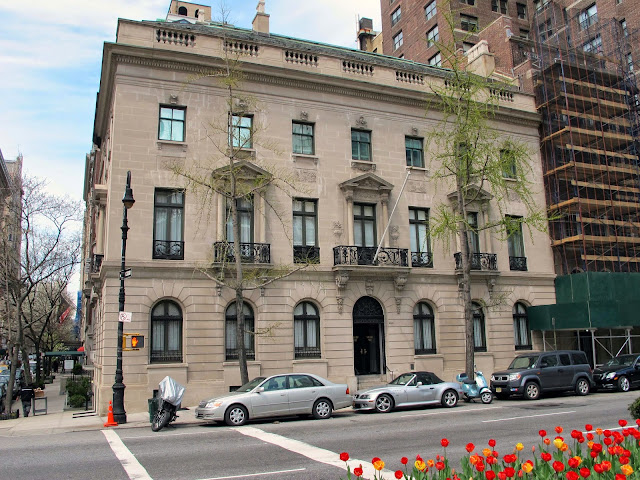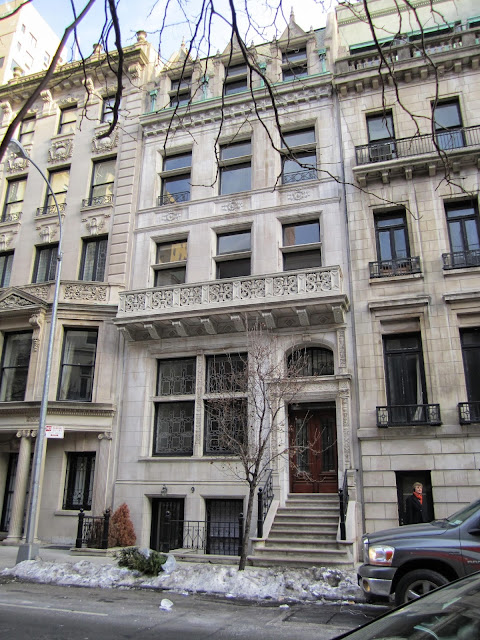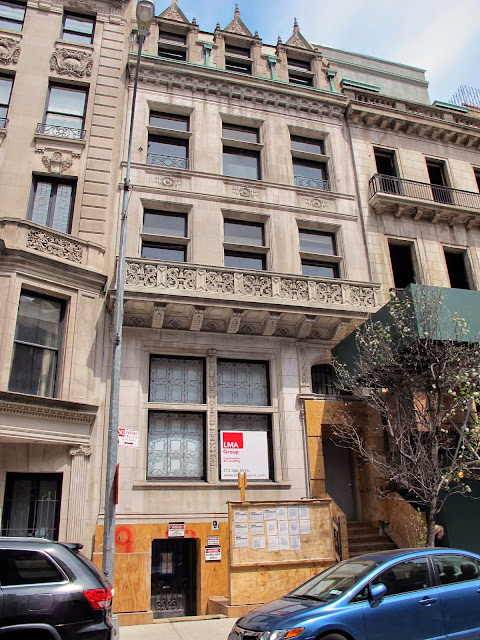It's so easy, isn't it? to criticize, to find fault, to blame, or in the words of Spiro Agnew (or actually of William Safire and Pat Buchanan, who wrote his speeches) to be one of the "nattering nabobs of negativity." I haven't thought of Spiro Agnew in years. Our larcenous former vice president thrilled the "silent majority" when he nailed anti-Vietnam-warriors with gems like "pusillanimous pussyfooters" and "hopeless, hysterical hypochondriacs of history" - at least until he was indicted for bribery and extortion.
What does this have to do with the beautiful ironwork on the facade of 3 East 64th St., a house designed in 1900 by Warren and Wetmore for Orme Wilson and his wife, "The" Mrs. Astor's daughter, Carrie? Actually, not much. (Sidebar: How charming is that little iron sprig, blooming perpetually amidst the wrought iron curves?) Today's post is about the constancy of beauty. Like spring, it always comes back. Instead of bleating about all the damage done to fine old buildings, today I'm going to acknowledge the good that Caesar also does.
Let's start with the Colony Club at Park and 62nd (Delano & Aldrich, 1916), not perhaps its designers' most distinguished work (it's a little boxy), but still and all an elegant neighborhood landmark.
Since my apartment is just OFF the corner of Park and 63rd Street, and my office is right ON the corner of Park and 59th, I walk past the Colony every single weekday. Recently all the club's windows were replaced. In large part (probably) because of Landmarks and Historic District legislation, the job was first rate. The new windows look precisely like the charming (and leaky) old originals. Window consciousness has come slowly to New York. Who could even count the number of uninformed landlords and coop boards who have substituted 6-over-6 or casement style windows with awful (if weather-tight) blank-looking 1-over-1 replacements in bronze colored anodized aluminum? Single sheet "picture windows" on the facades of fine prewar buildings on Fifth or Park - or anywhere, really - are even worse.
For as long as I can remember (which is getting to be an awfully long time), the main floor windows of the Colony were also barricaded with ugly iron bars. These presumably were a response to the rising urban panic of the late 1960s and early '70s, an era of crime, runaway graffiti, and a close call with municipal bankruptcy. Delano & Aldrich obviously had nothing to do with them. Now they're gone, leaving only a few mild and easy to overlook traces.
Nearby is this row of Neo-Grec, formerly high-stoop, brownstone-fronted, late 1870s, speculatively built row houses, located on the west side of Madison between 62nd and 63rd. There's a great quote somewhere from Henry James, if only I could find it, on the "unendurable" nature of West 53rd St., lined uniformly in his time with quite similar houses. Although the ones in these images have escaped replacement by a white brick horror, they have still been kicked around. Recently, Hermes' New York flagship, located across the street in the old Louis Sherry (later Limited) building, renovated the southernmost house.
Long before Hermes came along, the original window surrounds on this house had been scraped off by some misguided zealot. Hermes initially finished its renovation without replacing them. The result, for all the money spent, didn't look very good. In fact, it looked pretty bad. In a very short order, to my surprise and gratification, scaffolding went back up on the facade, and new window surrounds matching surviving originals on the house next door were installed. Good on you, Hermes.
I can't help wondering how many heavy plaster ceiling moldings, marble fireplace mantels and/or mahogany bannisters (even if painted red or brown) survive inside the un-renovated houses in this row.
A few years back the two houses at the north end of the row were combined into one swanky boutique office building that has also benefited from elevated window consciousness. The trio of houses between it and Hermes, despite posh street level stores and an uber-expensive restaurant called Nello, otherwise look pretty beat.
I've written about my own block - East 63rd between Madison and Park - several times, but # 45 is always worth another mention. It was built simultaneously with, and nestled demurely amongst, a row of five identical houses, two on either side of it retaining remarkably original looking facades. Like the Hermes house around the corner, the facade of #45 was stripped in the benighted past of all surface ornamentation. In 2010, its owners defined the "right thing" by putting it all back.
It's hard to tell which window is original and which is the 2010 repro.
The house in the image below exemplifies the "simplification" suffered by so many old city houses.
I've got a taste for limestone Neo-Renaissance city mansions like this one, located on the NWC of Park and 64th, and designed in 1911 by James Gamble Rogers for a rich paper manufacturer named Jonathan Bulkley. The Swedish government bought it from the Bulkley estate in 1946, and since 1951 its been the residence of their Consul General.
For most of that time, however, the windows and decorative ironwork have inexplicably been painted white. I have wondered for years - no, decades - who in the world was responsible for this striking lapse in taste.
Whoever did it has either redeemed himself (in my eyes, at least, assuming he cares), or perhaps been translated to a higher sphere. Whichever it was, the consul's windows have been redone, the beautiful ironwork painted a correct black, and the house is looking better than it has in years.
Too much good taste is not always a good thing. I agree with Mr, Mountchesney who, in Benjamin Disraili's 1845 novel "Sybil, or the Two Nations," observed, "I rather like bad wine. One gets so bored with good wine." The huge bow window on the renovated house in the image below, located on 65th just off Park, is bottom heavy, out of scale and should be painted black. For all that, I rather like it. The facade onto which it has been grafted is infinitely more interesting than that of the house next door. The room behind it must be equally so.
The lessons of Spiro Agnew aside, two old brownstones flanking 67th Street on the east side of Madison make "right and wrong" a clear issue of "black and white." A few years ago, the northern of the two, seen in the images below, got a first class facade restoration.
At practically the same time, the southern house disappeared behind construction netting and my hopes soared.
Then the netting came down and a part of me wished they'd put it back up.
I suppose there was some improvement - well, maybe not much.
The netting has gone back up, and so have my hopes.
My real estate partner Krisztina and I represent what we like to call a "chic" prewar rental building on the Park block of 67th, so I am quite regularly here. It is a block of mansions, half of which seem at present to be under renovation. Notable among them is #14-16, seen netted below. It is a double house designed in two stages. John Duncan designed #16 in 1905, then in 1919 its new owner Jeremiah Milbanks also bought #14 next door and hired Dodge and Morrison to combine the two.
In 1977, before the days of the Upper East Side Historic District, Penthouse publisher Bob Guccioni bought 14-16 East 67th St. and turned it into what Curbed New York called "five floors of disco-era glory." These included way too many marble statues, a Mediterranean themed courtyard, and an indoor pool surrounded by columns decorated with likenesses of Mr. Guccioni's face - not to mention those horrible modern windows facing the street.
In 2008, hedge fund mogul Philip Falcone bought the house for $49 million (it was the top of the market) and set about undoing the damage. From what's visible from the street, things look promising. However, six years have passed, years during which Mr. Falcone has made some highly publicized financial missteps. I don't know what'll happen next, although guys like Mr. Falcone usually land on their feet.
Another renovation/restoration - or, more correctly, a total reconstruction - is underway across the street at 11 and 13 East 67th St. Jeff Koons, the artist who, according to New York Magazine, is "known for his appreciation of American kitsch," is combining two limestone mansions into one historically accurate (at least from the street) mega-mansion.
Next door to the Koons project is 9 East 67th, seen below soon after a recent renovation that returned it to single family use. This house had been brutally altered, its interior chopped to pieces, its exterior steps torn off and replaced with a terrible looking front door.
Wonderful as the reconstructed stoop may have been, the front door and iron railings looked more appropriate to an East 80s walk-up off Second Ave.
Typical of our times, 9 East 67th is being done all over again. I'm hoping door and iron railings find the anonymity they deserve.
Mansion improvement is underway all over the Upper East Side and, thanks to landmark and historic district legislation, it's making things look a lot better. Great looking or not, the investment in private mansions begs the question of income inequality, a phenomenon as dangerous to society as cancer is to the body. But...that's a subject for another day.
Speaking of income inequality, some people are actually building new houses, like this limestone manse on the Junior League block of East 80th St., which is the equal of anything old.
On Easter Sunday I took my daughter, son-in-law and granddaughter to lunch at a smart club near Millbrook. We sat under a big tent with maybe 200 other people, filled our plates with cleverly presented food, admired darling children darting underfoot, and appreciated the luxurious efficiency of the afternoon. My daughter caught up with pretty girls with whom she'd gone to school, girls accompanied, I might add, by equally pretty boyfriends and husbands. Toward the end of the afternoon, Jazzy turned to me and said, "Thank you for lunch, Dad. I feel completely comfortable here, but you know, it's really not my scene." Truth be told, it's hardly my scene either, although I've lived in it for most of my life. I associate my world with architectural beauty, contrived and artificial at times but, having been seduced by it, I remain dazzled, like the man with an unworthy lover.
Speaking of beauty, how charming are these limestone reliefs on the 70th St. side of 720 Park?
Restoring the amputated stoop of an old brownstone is a cardinal "right thing." I'd call this one, ornamenting the facade of 162 East 70th Street, "inspirational."




















































